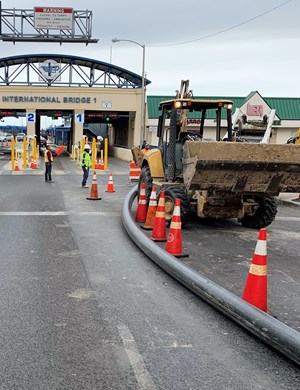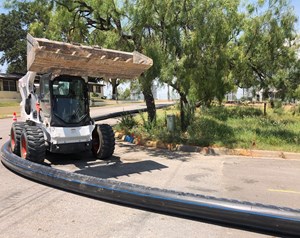October 2021 Vol. 76 No. 10
Features
Texas Water System Tackles Fractured Pipeline
While Eagle Pass, Texas, can’t solve the high heat and low amount of rainfall it receives every year in the arid southwest, it has been able to fight water loss due to breaks in its pipeline. The city recently completed an upgrade to its mainline potable water service that saw some 100,000 feet of PE4710 high-density polyethylene (HDPE) DR 11 pipe installed in diameters from eight to 16 inches, to replace older cast iron lines. Using open cut, horizontal directional drilling (HDD) and pre-chlorinated pipe bursting, Murphy Pipeline Contractors Inc. (Jacksonville, Fla.) completed the job in early 2021.
The Eagle Pass Water Works System (EPWWS) has nearly 20,000 customers and a potable water system with more than 500 miles of main lines and services, and nearly 1,600 fire hydrants. The Rio Grande River is the city’s only means of water supply. According to one report, the existing amount of water rights owned by EPWWS is not sufficient to provide adequate water to the area.
While the project was first considered in 2013, the need for funding delayed the bidding solicitation process until 2018 for the city that has nearly 30,000 residents. The majority of the project was funded through the State of Texas drinking water program enabling the city to secure the needed $17.4 million.
In its entirety, the project replaced nearly 100,000 linear feet of existing cast iron water pipe and added 1,300 new water services using HDPE tubing to connect the water main to existing and new water meters.
Long-term development
“Originally, Eagle Pass started looking at this project probably going back more than 10 years ago,” explained Todd Gafenauer, educational director for Murphy. “HDPE pipe was selected as it solved one of the main reasons why the existing cast iron was failing. Many of those mains would fail due to shifting soils caused by the extreme heat and lack of moisture in the soils. Oklahoma and Texas generally deal with both freeze/thaw and dry/wet cycles causing severe breaks in the old pipe.
“The EPWWS general manager came to one of our other pre-chlorinated pipe busting projects in Texas to get acquainted with the technology. He knew that this work was coming up. Eagle Pass, like most municipalities in the country, are at a very challenging position because they have old cast iron that is leaking everywhere. They also have very poor fire flow protection because of the corrosion inside the lines. So, they have been kind gearing up for the project for a number of years, came out and saw the technology and knew that is what they wanted.”
The pre-chlorinated pipe bursting method has a history of more than 40 years and was developed by the United Kingdom water industry to address its failing cast iron water mains. The HDPE pipe is bacteriologically disinfected and pressure tested above grade prior to installation, which produces multiple construction efficiencies. The crews will often also set up temporary services to keep homeowners and business connected to water service throughout construction. Murphy introduced the process to the North American market in 1999.
There are other advantages to using the pipe, according to the Plastics Pipe Institute Inc. (PPI), a major North American trade association representing the plastic pipe industry.
“The use of HDPE in drinking water systems continues to grow and is specified per the ANSI/AWWA C901-20, ANSI/AWWA C906-15 and NSF 61 for service, distribution and transmission, and is designed and installed per AWWA M55-20,” stated Camille George Rubeiz, P.E., F. ASCE, co-chair, Municipal Advisory Board and senior director of engineering, Municipal and Industrial Division of PPI.
“HDPE pipe has been used in municipal water applications for more than 50 years. HDPE’s heat-fused joints create a leak-free, self-restraint, monolithic piping system that can be pulled from one area to another with minimum disruption to traffic or the surrounding communities. The fused joint also eliminates infiltration into the pipe and exfiltration into the environment.
“HDPE has other benefits which include resistance to water hammer, fatigue, ground movements, freezing temperatures, earthquakes, corrosion and tuberculation.”
Versatile
Rubeiz also said that HDPE pipe is versatile and can be used in methods of underground installation. “Eagle Pass is an example of HDPE providing for the needs of the contractor, who had to make decisions in the field. It didn’t matter that a change at the last minute had to be made from trenchless to open cut, the HDPE pipe could be used immediately for either.”
Because trenchless methods of installing HDPE pipe have grown in popularity, the Municipal Advisory Board (MAB) has published several free technical documents, such as The MAB Guidelines for PE4710 Pipe Bursting of Potable Water Mains (MAB-5-2019) and MAB Guidelines for Use of Mini-Horizontal Directional Drilling for Placement of HDPE (PE4710) Pipe in Municipal Applications (MAB-7-2020). All documents and software are available at: plasticpipe.org/municipal_pipe/mid-mab-publications.html.
“This water system project was critical for the citizens of Eagle Pass,” stated David Fink, president of PPI. “The water system was not adequate for the needs of the existing population and would not be able to accommodate any future growth. Plus, the amount of water leaking through the old pipes cost the Eagle Pass Water Works System and its customers untold amounts of money; and, more troubling, was the amount of wasted water in a region that treasures every precious drop.”
The 50-foot-long sections of HDPE pipe from JM Eagle were fused together by the Murphy crew using a McElroy Trackstar 500, and the Scandinavian No-Dig T87 with a pulling capacity of 92 metric tons was used for the pipe bursting segments. The HDPE pipe has a pressure rating of 200 psig at 80 degrees F and can handle total pressure during recurring surge of 300 psig and total pressure during an occasional surge of 400 psig.
The pre-chlorinated pipe bursting used more than 20,000 feet of 8-, 10- and 12-inch diameter HDPE PE4710 pipe.
“The original idea was to use pipe bursting for the entire project,” explained Murphy Pipeline’s Gafenauer. “But one of the challenges we ran across was that some of the lines were extremely shallow. It was more of a design build project onsite. We would dig down, find out what we had and then make the decision in the field. But because our crews have experience with all the ways to install the pipe, it wasn’t a problem to change on-the-fly.
“Taking on a project of this size, using pre-chlorinated pipe bursting, produced a significant savings in terms of impact to the community during construction and helped to reduce the project’s schedule,” he added. “This is one of the largest, HDPE water main projects done at one time in North America that I’m aware of and our team is proud to be a part of it.”
FOR MORE INFORMATION:
Murphy Pipeline Contractors Inc., (904) 764-6887, murphypipelines.com
McElroy Manufacturing, (918) 836-8611, mcelroy.com
Plastics Pipe Institute, (469) 499-1044, plasticpipe.org
JM Eagle, (800) 621-4404, jmeagle.com
Scandinavian No-Dig, +45 98 34 16 88, no-dig.dk






Comments